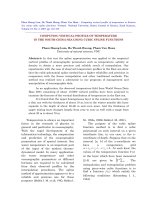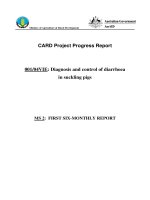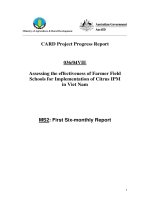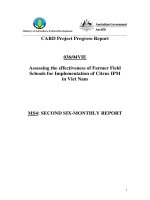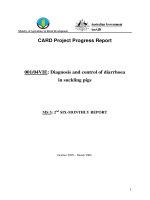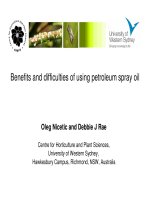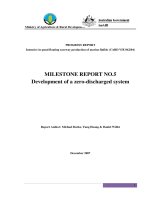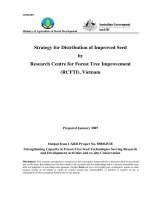Báo cáo nghiên cứu khoa học: "Cell suspension culture of Zedoary (Curcuma zedoaria Roscoe)" pps
Bạn đang xem bản rút gọn của tài liệu. Xem và tải ngay bản đầy đủ của tài liệu tại đây (151.11 KB, 7 trang )
VNU Journal of Science, Natural Sciences and Technology 27 (2011) 64-70
64
Cell suspension culture of Zedoary
(Curcuma zedoaria Roscoe)
Vo Chau Tuan
1,2
, Vu Duc Hoang
1
, Nguyen Hoang Loc
1,
*
1
Institute of Resources, Environment and Biotechnology, Hue University, Hue, Vietnam
2
College of Education, Da Nang University, Da Nang, Vietnam
Received 09 June 2010
Abstract. We report here the protocol for Zedoary (Curcuma zedoaria Roscoe) callus and cell
suspension cultures. The MS medium supplemented with 2% sucrose, 1.0 mg/l 2,4-D and 1.0 mg/l
BA was effective for callus induction from in vitro leaf-base explants of Zedoary. During
subcultures, secondary proliferated calli were subsequently produced from initial induced calli on
the MS medium with 0.5 mg/l 2.4-D and 0.5 mg/l BA. These calli were light yellow in color,
compact and friable. The cell suspension culture for Zedoary was established using 3 g fresh
weight inoculum in a batch culture on the MS medium supplemented with 3% sucrose, 1.5 mg/l
2,4-D and 0.5 mg/l BA. The highest biomass of 10.44 g fresh weight (0.66 g dry weight) was
obtained after 14 days of culture in 50 ml liquid medium of 250 ml Erlenmeyer flask with shaking
speed of 120 rpm. Results from this study might be a well established foundation for further
studies on Curcuma zedoaria Roscoe in order to serve as a potential source for secondary
metabolites production in large scale.
Keywords: Callus, cell biomass, cell suspension, Curcuma zedoaria, medicinal plant
1. Introduction
∗
Zedoary (Curcuma zedoaria Roscoe) plant,
a vegetatively propagated species of the
Zingiberaceae family, is an aromatic
herbaceous plant with a rhizome growing
mainly in South Asian and South-East Asian
countries, and China [1]. Zedoary is a valuable
medicinal plant, the essential oil obtained from
rhizome has been reported to have antimicrobial
activity and be clinically used in the treatment
of cervical cancer, the water extract of Zedoary
_______
∗
Corresponding author. Tel.: 84-54-6505051.
E-mail:
demonstrated antimutagenic activity [2]. It has
been also used for stomach diseases,
hepatoprotection [3], treatment of blood
stagnation, and promoting menstruation as a
traditional medicine in Asia [4]. Furthermore,
the Zedoary has anti-inflammatory potency
related to its antioxidant effects [3].
Higher plants are a valuable source of wide
range of secondary metabolites, which are used
as pharmaceuticals, agrochemicals, flavours,
fragrances, colours, biopesticides and food
additives [5]. In the end of 1960s, plant cell
culture technologies were introduced as a tool
for both studying and producing plant
secondary metabolites. A highly potent
V.C. Tuan et al. / VNU Journal of Science, Natural Sciences and Technology 27 (2011) 64-70
65
secondary metabolites that is used in
pharmaceuticals and food additives have been
produced through plant cell suspension cultures
in large-scale [6, 7]. Cell suspension culture is a
requirement for the production of chemicals
from plants in a way quite similar to that used
for microorganisms, where the utilization of
bioreactor becomes feasible [8]. The purpose of
this study is to establish an efficient suspension
cell culture protocol for C. zedoaria as a
starting point to produce bioactive compounds
in plant cell culture.
2. Materials and methods
2.1. Callus culture
Leaf-base explants of 0.5×0.5 cm were
excised from in vitro growing Zedoary plants
on the Murashige and Skoog (MS) [9] solid
medium supplemented with 2% (w/v) sucrose,
20% (v/v) coconut water, and 2 mg/l
naphthaleneacetic acid (NAA) [10]. The
explants were placed on the MS solid medium
supplemented with 2% (w/v) sucrose, 0.25 to
4.0 mg/l 2,4-dichorophenoxyacetic acid (2,4-
D), and 0.25 to 4.0 mg/l benzyladenine (BA)
for callus induction and its proliferation. The
pH of the medium was adjusted to 5.8, and then
it was autoclaved at 121
o
C for 15 min. The
cultures were incubated at 25±2
o
C under an
intensity of 2,000-3,000 lux with a photoperiod
of 10-h day light.
2.2. Establishment of cell suspension culture
Cell suspension cultures were initiated
through the agitation of 3 g of callus in 250 ml
Erlenmeyer flasks containing 50 ml MS liquid
medium supplemented with 2% (w/v) sucrose,
0.5 mg/l 2,4-D and 0.5 mg/l BA for 10 days at
120 rpm until a suspension of free cells formed.
Then, 3 g of cells from initial culture was
transferred on the MS medium supplemented
with different plant growth regulators (2,4-D
and BA) and sucrose for investigation of
biomass production. The suspensions were
placed on a rotary shaker at 120 rpm for 18
days under the same conditions as for the callus
culture except an intensity of 500 lux.
Samples were obtained every two days to
determine the cell biomass in both fresh and dry
weights. For measurement of fresh cell weight,
the cells in the suspension culture were filtered,
washed with distilled water, collected, and
weighed. The dry cell weight was determined
by drying the fresh cell biomass at 50
o
C until a
constant weight was attained.
Growth index = Final fresh cell
weight/Initial inoculums fresh cell weight.
2.3. Statistical analysis
The experiments of callus and cell
suspension culture were conducted with a
minimum of three replicates. All experiments
were repeated three times. The data were
analyzed by mean ± standard error followed by
comparison of the means with the Duncan’s test
at p<0.05.
3. Results and discussion
3.1. Callus induction and proliferation
As shown in Table 1, the effects of 2,4-D
and BA on callus induction were initially tested
using the leaf-base explants of in vitro Zedoary
plant. The MS medium with 1.0 mg/l 2,4-D and
1.0 mg/l BA showed the strongest induction
with 46% of explants produced callus; calli
were white in color and soft (Fig 1A). The other
combinations of plant growth regulators
resulted in non-growth or poor growth of
V.C. Tuan et al. / VNU Journal of Science, Natural Sciences and Technology 27 (2011) 64-70
66
Zedoary callus. No callus was formed on
medium without 2,4-D and BA. At high
concentrations of 2,4-D (3.0-4.0 mg/l) and BA
(3.0-4.0 mg/l), or low concentration of 2,4-D
(0.5 mg/l) and BA (0.5 mg/l) the callus
obtained was white in color and viscous (Fig
1B). It was found that medium concentrations
of 2,4-D (1.0-2.0 mg/l), in combination with
BA (1.0-2.0 mg/l), had significant effects on
callus formation. Several studies had been
reported regarding the effects of plant growth
regulators on callus growth of Zedoary [8, 11]
found callus was induced from root segments of
in vitro Zedoary plants. The explants were
cultured on the MS medium supplemented with
3% sucrose, 13.4 µM NAA and 2.2 µM BAP in
the dark. According to [12], no callus formation
from the explants of Zedoary on the MS
medium with 2,4-D. Callus induction and
growth were obtained by inoculating root
segments on the MS medium supplemented
with 1.0 mg/l NAA and incubation in the dark.
In this work, other plant growth regulators
treatments (NAA and kinetin) also had been
done on callus induction from Zedoary (data
not shown) but were terminated due to several
problems such as weak callus induction
frequency (NAA) or browning callus after three
times of subculture (kinetin).
Table 1. Callus induction and morphogenesis of Zedoary leaf-base explants
2,4-D (mg/l) BA (mg/l) % explant produced callus Callus induction Callus morphogenesis
0.0 0.0 0.00 - -
0.5 0.5 15.74
c
++ White and viscous
1.0 1.0 46.01
a
++++ White and soft
2.0 2.0 40.10
b
++++ White and soft
3.0 3.0 10.20
d
+++ White and viscous
4.0 4.0 8.20
e
++ White and viscous
-: no induction; +: induction; ++: low production of callus; +++: medium production of callus; ++++:
high production of callus
Different letters indicate significantly different means using Duncan’s test (p<0.05)
Fig. 1. Callus induction culture of Zedoary. A: White and soft callus, B: White and viscous callus.
A
B
A
V.C. Tuan et al. / VNU Journal of Science, Natural Sciences and Technology 27 (2011) 64-70
67
White and soft calli (primary calli) were
transferred on the MS media supplemented with
different concentrations of 2,4-D and BA for
proliferation. Calli obtained from the induction
medium with 2.0 mg/l 2,4-D and 2.0 mg/l BA
turned brown and dead in all subcultures. Calli
obtained from the induction medium with 1.0
mg/l 2,4-D and 1.0 mg/l BA developed into
secondary calli on the medium containing 0.5
mg/l 2,4-D and 0.5 mg/l BA (Table 2). Other
concentrations of 2,4-D and BA did not show
any positive response for callus proliferation in
any of the tested formulars of explants when
evaluation was carried out four weeks after
subculture. The secondary calli which were
light yellow in color, compact and friable
obtained after four weeks of culture were
subcultured and maintained in the fresh
medium with the same composition every two
weeks (Fig. 2A).
Table 2. Growth ability and morphogenesis of Zedoary primary callus
2,4-D (mg/l) BA (mg/l) Callus growth Callus morphogenesis
0.25 0.25 ++ White and viscous
0.50 0.50 ++++ Light yellow, compact and friable
1.00 1.00 ++ White and soft
2.00 2.00 ++ White and viscous
4.00 4.00 - Brown and dead
Fig. 2. Secondary callus and suspension cell of Zedoary. A: Light yellow, compact and friable callus, B: Suspension cell
3.2. Cell suspension culture for biomass
production
In order to investigate cell biomass
accumulation, a suspension culture was
established. Approximately 3 g fresh weight of
callus was transferred in 50 ml the liquid MS
medium containing 0.25 to 2.5 mg/l of 2,4-D
and 0.5 mg/l BA. Suspension cells were
initially generated as shown in Fig. 2B within 2
weeks of culture. In order to maintain the
suspension culture, 3 g of cells was transferred
to fresh MS liquid medium at 10 days interval.
Growth of cell was also determined by fresh
and dry weight measurement (Fig 3A and 3B).
The fresh and dry weights of cells were
recorded every two days until 18 days of culture
time. It was observed that cell biomass was
increased by culture time (data not shown). The
MS medium supplemented with 1.5 mg/l 2,4-D
and 0.5 mg/l BA showed the highest biomass
accumulation compared to other combinations
of 2,4-D and BA. Day 14
th
showed the
maximum biomass accumulation with 7.22 g of
fresh weight (approximately 0.55 g of dry
weight) (Table 3).
B
A
V.C. Tuan et al. / VNU Journal of Science, Natural Sciences and Technology 27 (2011) 64-70
68
Table 3. Effect of plant growth regulators on the production of Zedoary cell biomass
BA (mg/l) 2,4-D (mg/l) Fresh weight (g) Dry weight (g) Growth index
0.5 0.25 5.12
bc
0.35
b
1.71
0.5 0.5 5.91
b
0.44
ab
2.05
0.5 1.0 6.20
b
0.46
ab
2.06
0.5 1.5 7.22
a
0.55
a
2.41
0.5 2.0 6.03
b
0.43
ab
2.19
0.5 2.5 6.01
b
0.42
ab
2.18
Fig. 3. Cell biomass of Zedoary. A: Fresh cell biomass, B: Dry cell biomass.
As shown in Table 4, the concentrations of
sucrose to significantly affect on the biomass
accumulation of cell, highest fresh cell weight
were attained in media containing sucrose
concentration of 3% (10.44 g with growth index
of 3.48). However, despite sucrose being an
indisputably important carbon and energy
source, increasing its concentration from 4 to
6% resulted in fresh cell weight reductions and
significantly reduced at sucrose concentration of
7%. This decline in performance might be
attributed to the inhibition of nutrient uptake as
the osmotic potential was enhanced and the
medium became more viscous. As have shown
in Vitis vinifera that a higher concentration of
sucrose can act as an osmotic agent, with
mannitol having a similar effect on growth [13].
Additionally, this retardation in growth could
be caused by a cessation in the cell cycle when
nutrients are limited and sucrose concentrations
are higher [14, 15].
Table 4. Effect of sucrose concentration on the production of Zedoary cell biomass
Sucrose concentration (g/l) Fresh weight (g) Dry weight (g) Growth index
20 7.22
c
0.55
b
2.41
30 10.44
a
0.66
a
3.48
40 8.85
b
0.64
a
2.95
50 8.80
b
0.65
a
2.93
60 8.75
b
0.70
a
2.92
70 6.75
c
0.60
a
2.25
A B
V.C. Tuan et al. / VNU Journal of Science, Natural Sciences and Technology 27 (2011) 64-70
69
Typical cell growth curves constructed from
suspension culture are shown in Fig.4. These
curves indicated a lag phase was quite short and
difficult to predict, followed by an exponential
phase of growth lasting approximately 12 days,
ending up in the death phase. The whole growth
curve took approximately 18 days to be
completed and presented more three folds fresh
cell biomass accumulation [8] reported that 0.5
g Zedoary cell culture in the presence of 3%
sucrose, 13.4 µM NAA and 2.2 µM BAP
showed a typical growth curve with a maximum
fresh weight (approximately 6 g) after about 35
days of culture in 10 ml medium at speed of 60
cycles/minute. [12] also showed that a typical
growth curve of 1 g Zedoary cell culture on the
medium supplemented with 1.0 mg/l NAA. The
fresh biomass reached a highest value
(approximately 8 g) after more 20 days of
culture in 75 ml medium at speed of 100 rpm.
0
0.2
0.4
0.6
0.8
0
2
4
6
8
10
12
0 2 4 6 8 10 12 14 16 18
Dry cell weight (g)
Fresh cell weight (g)
Culture time (days)
Fresh cell weight
Dry cell weight
Fig 4. Biomass production of Zedoary cells on the
medium with 3% sucrose, 1.5 mg/l 2,4-D and 0.5 mg/l
BA (p<0.05).
4. Conclusion
The suspension culture offers many
advantages to scale-up production of secondary
metabolites in plant cells of interest. In this
study, we established an efficient cell
suspension culture protocol for Zedoary plant.
Their suspension cells derived from secondary
calli proliferated on the MS medium
supplemented with 3% sucrose, 1.5 mg/l 2,4-D
and 0.5 mg/l BA had a homogenous feature
from a morphological viewpoint. The most
important observation of this study is that
suspension cells of Zedoary had a high
proliferation potential and the finding will
provide some basic information for the
production of bioactive compounds from
Zedoary cell culture in further.
Acknowledgements
This study was supported by a grant from
the Basic Research Program in Natural Science
of the Vietnamese Ministry of Science and
Technology (2006-2008).
References
[1] L.D. Moi, T.M. Hoi, D.D. Huyen, T.H. Thai,
N.K. Ban, Plant resources of Vietnam-Bioactive
plants, Vol 1. Agriculture Publishing House, Ha
Noi, Vietnam, 2005.
[2] W.Jr. Syu, C.C. Shen, M.J. Don, J.C. Ou , G.H.
Lee, C.M. Sun, Cytotoxicity of curcuminoids
and some novel compounds from Curcuma
zedoaria, J. Nat. Prod. 61(1998) 1531.
[3] T. Yoshioka, E. Fuji, M. Endo, Anti-
inflammatory potency of dehydrocurdione, a
Zedoary-derived sesquiterpene, Inflamm. Res. 47
(1998) 476.
[4] H. Matsuda, T. Ninomiya, M. Yoshikawa,
Inhibitory effect and action mechanism of
sesquiterpenes from Zedoariae rhizoma on D-
galactosamine/lipopolysaccharide-induced liver
injury, Bioorg. Med. Chem. Lett. 8 (1998) 339.
V.C. Tuan et al. / VNU Journal of Science, Natural Sciences and Technology 27 (2011) 64-70
70
[5] F. Bourgaud, A. Gravot, S. Milesi, E. Gontier,
Production of plant secondary metabolites: a
historical perspective, Plant Sci. 161 (2001) 839.
[6] S. Ramachandra Rao, G.A. Ravishankar, Plant
cell cultures: chemical factories of secondary
metabolites, Biotechno.l Advances 20 (2002)
101.
[7] H.S. Taha, M.K. El-Bahr, M.M. Seif-El-Nasr, In
vitro studies on Egyptian Catharanthus roseus
(L.) G. Don.: 1-callus production, direct
shootlets regeneration and alkaloids
determination, J. Appl. Sci. Res. 4 (2008) 1017.
[8] M.O. Mello, C.T.S. Dias, A.F. Amarai, Growth
of Bauhinia forficata, Curcuma zedoaria, and
Phaseolus vulgaris cell suspension cultures with
carbon sources, Sci. Agric. 58 (2001a) 481.
[9] T. Murashige , F. Skoog, A revised medium for
rapid growth and bioassays with tobacco tissue
culture, Physiol. Plant 15 (1962) 473.
[10] N.H. Loc, D.T. Duc, T.H. Kwon, M.S. Yang,
Micropropagation of Zedoary (Curcuma
zedoaria Roscoe)-a valuable medicinal plant,
Plant Cell Tiss. Organ Cult. 81 (2005) 119.
[11] M.O. Mello, M. Melo, B. Appezzato-da-Glória,
Histological analysis of the callogenesis and
organogenesis from root segments of Curcuma
zedoaria Roscoe, Braz. Arch. Biol. Technol. 44
(2001b) 197.
[12] J.I. Miachir, V.L.M. Romani, A.F. de Campos
Amaral, M.O. Mello, O.J. Crocomo, M. Melo,
Micropropagation and callogenesis of Curcuma
zedoaria Roscoe, Sci. Agric. (Piracicaba,
Braz) 61 (2004) 427.
[13] C.B. Do, F. Cormier, Effects of low nitrate and
high sugar concentrations on anthocyanin
content and composition of grape (Vitis vinifera
L) cell suspension, Plant Cell Rep. 9 (1991)
500.
[14] A.R. Gould, N.P. Everett, T.L. Wang, H.E.
Street, Studies on the control of cell cycle in
cultured plant cells: Effect of nutrient limitation
and nutrient starvation, Protoplasma 106 (1981)
1.
[15] C.H. Wu, Y.H. Dewir, E.J. Hahn, K.Y. Paek,
Optimization of culturing conditions for the
production of biomass and phenolics from
adventitious roots of Echinacea angustifofia, J.
Plant Biol. 49 (2006) 193.
Nuôi cấy tế bào huyền phù của cây nghệ đen
(Curcuma zedoaria Roscoe)
Võ Châu Tuấn
1,2
, Vũ Đức Hoàng
1
, Nguyễn Hoàng Lộc
1
1
Viện Tài nguyên Môi trường và Công nghệ Sinh học, Đại học Huế
2
Trường Đại học Sư phạm, Đại học Đà Nẵng
Nghiên cứu này trình bày phương thức nuôi cấy callus và tế bào huyền phù của cây nghệ đen
(Curcuma zedoaria Roscoe). Môi trường MS bổ sung 2% sucrose; 1,0 mg/l 2,4-D và 1,0 mg/l BA
thích hợp cho nuôi cấy callus từ bẹ lá của cây nghệ đen in vitro. Trong quá trình nuôi cấy, các callus
thứ cấp được tạo thành từ callus sơ cấp trên môi trường MS có bổ sung 0,5 mg/l 2.4-D và 0,5 mg/l
BA. Các callus này có màu vàng, rắn và rời rạc. Nuôi cấy tế bào huyền phù được thiết lập với 3 g sinh
khối callus tươi nuôi trong bình tam giác thể tích 250 ml, chứa 50 ml môi trường MS có bổ sung 3%
sucrose; 1,5 mg/l 2,4-D và 0,5 mg/l BA với tốc độ lắc 120 vòng/phút. Sinh khối cao nhất đạt 10,44 g
trọng lượng tươi (0,66 g trọng lượng khô) sau 14 ngày nuôi cấy. Các kết quả này là cơ sở cho những
nghiên cứu sâu hơn về cây nghệ đen nhằm cung cấp nguồn nguyên liệu tế bào để sản xuất các hợp chất
thứ cấp ở qui mô lớn.
Từ khoá: Callus, sinh khối tế bào, tế bào huyền phù, cây nghệ đen, cây thuốc.
